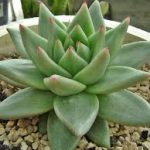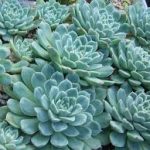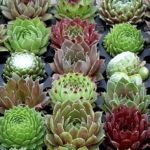The Echeverias plants are a great genus of flowering plants, of the Crassulaceae family.
The Echeveria are very popular succulent plants that grow in attractive rosettes with beautiful leaves in a variety of colors and sometimes, dazzling flowers. These plants have been extensively hybridized, so, in addition to the main species, there are many varieties that have been bred especially to obtain interesting leaves and colors.
Today, we have for you, the Complete Guide on How to Care for and Grow Succulent Plants – Crassas – Echeveria
 Its name is due to the Mexican botanist, Atanasio Echeverría, in the 18th century.
Its name is due to the Mexican botanist, Atanasio Echeverría, in the 18th century.
The most recognized and main species are among many, E. elegans, E. agavoides, E. laui, E. lilacin, E. pulvinata , E. runyonii, E. pilosa, E. glauca, E. gibbiflora , E. pelucida.
Table of Contents
Types of Echeverias
The most common vulgar names are Echeverio, Rosa de Alabastro, and Orejas de burro.
They are succulent or succulent plants so they can contain water deposits in the leaves.
They present formations of rosettes of fleshy leaves, which may not have a stem, or be very short.
Description of Echeverias
The leaves of the Echeverias can be covered with fine hair and are usually spatula-shaped and rounded.
The flowers appear at the end of a peduncle and can have different colors (orange, red, yellow), blooming towards the end of summer.
They are very decorative and go very well together with recreations in rockeries or pots and large planters on terraces.
On our balconies, with warm weather, they go well.
They need a location in full sun and high temperatures, although in winter they should be at least between 7ºC and 10ºC.
They do not resist frost.
Care and Cultivation of Echeveria

The Echeveria, inside or outside, does not like to be kept too wet, but they do not like to be left too dry. Usually, we find that succulents like more water than most people think. In a house, the dry temperatures of the home dry things even faster. You do not want your soil to be completely dry or this will cause the roots of the plant to wilt.
When you water the Echeveria, water the soil and not the rosette. Pour the water on the ground until it drains from the bottom. Repeat this a couple of times. Then do not water again until the soil has dried. You do not want your plant to remain soaked all the time. To help prevent this, do not let the pot sit on a saucer full of water. The time between watering depends on the temperatures and conditions of the plant.
The most common problems observed in Echeveria plants are due to bad irrigation habits. Both excess and low irrigation can produce similar symptoms. So you must try, obviate and avoid wilting, like leaf fall. You must know better your own watering habits and that of your plants. Watch your plants and make the necessary adjustments.
 Soil for Echeveria
Soil for Echeveria
Like all succulents, the Echeveria need soil that drains quickly. This helps prevent moisture from rotting the roots. Many producers will create their own special mix of soil and pearlite. However, soil from good quality pots or a mixture of cactus will work well. As a general rule, when you squeeze a handful of moist soil, you must undo it again when it is released.
You will often read that “sandy” soil is the best soil requirement for succulents. This simply means that the soil needs to drain well. If you add real sand to your floor, make sure it is coarse grain. Fine sand will clog the air pockets in the ground.
If you keep your plants alive for several years, you should re-transparent them. Getting a new land-change every two years will keep them healthy and growing well.
Fertilizer
Fertilizer is not an essential requirement for Echeveria. Succulents grow natively in the soil without many nutrients. Therefore, they are especially susceptible to burning by adding fertilizers. However, they may benefit from an additional but occasional boost. Use a slow-release fertilizer at the beginning of spring, or a liquid fertilizer diluted 2-4 times more than normal and used less often than recommended. Use a low nitrogen mixture or a cactus fertilizer.
Containers and flower pots
When it comes to the Echeveria, you have a wide range of containers to choose from. In general, the smallest possible size, or something that is simply bigger than the rosette is the right choice. People sometimes worry about exceeding the limit. This is when you use a large container for a small plant. The potential problem is that a larger volume of soil may contain more moisture and lead to the risk of decay. However, the soil you use with the succulents should have excellent drainage anyway and the larger pots should not pose any problem. To find the container that you think looks good, big or small, and let your Echeveria grow.
Pests of the Echeverias
These plants are not easily attacked by pests and diseases.
The most usual is the rottenness due to excess irrigation and without allowing the substrate to dry between irrigations.
Propagation and transplantation
Propagation methods
The prolific production of the echeveria propagation gives an account of the common name that is given to them ” chickens and chicks ” this is a condition that many echeverias share with the succulent species Sempervivum. The central rosette, or “mother” plant, produces several young ones under its oldest leaves. Remove the new offspring from plants grown for propagation revitalizes the motherland. The reproductive arsenal of offsprings also includes propagation by means of cuttings. Another is by means of seeds. The seeds of offspring plants reproduce faithfully, but their seedlings take between 18 months and three years to mature. Something very slow compared to the other methods.
The seed echeveria succulents do not reliably inherit the characteristics of their parents.
Soil conditions for propagation
The means to allow proper rooting is critical to the success of your propagation efforts. Light, fast draining substrates (soil for succulent pots, perlite or pumice) have the loose texture necessary for rapid rooting. Planting cuttings directly on the ground is an option only if you have a loose, well-drained soil; Putting them in containers in this type of soil that allows rooting maximizes the possibilities of developing healthy root systems.
Propagation through transplantation
Take the offsprings of echeveria from their mother plant it is recommended that it be early spring this time it gives them time for their roots to settle before the winter dormancy. Cut the thin stems that bind the chicks to the offspring with a clean, sharp knife. Gently lift the offspring off the ground, taking care to keep their small roots intact. Place them on the ground in a shallow bowl; Placing them only in contact with the ground is usually enough for them to take root. Put them in the light, away from the direct sun, and keep the medium evenly moist only while the roots develop.
Propagation by means of cuttings
Cut the thick and healthy leaves of the mother plant with a clean and sharp knife. Put them on a tray, leaving them in a warm place away from the direct sun until their cut edges develop calluses. The detached cuttings often rot in the middle of moist rooting. So you must keep the observation. Check them daily; Callus formation takes between one day and two weeks. When they heal, place the leaves upright in the middle of the pot. Supporting them against the edges of the container or between two cut gardening stakes ensures contact with the environment. And you will notice that small rooted plants emerge from the bases of withered leaves.
Last considerations
The new separated plants of the echeveria mother plant and the leaves rooted by means of cuttings, which are placed in pumice stone or pearlite eventually need to be transplanted to a mixture of substrate for succulents in pots or to a garden soil that is loose. Soils that are used for rooting can not supply enough nutrients to support their growth. So I recommend that once you see that you have been successful in propagation, you should transplant your echeveria succulent plants into a new soil so that they grow optimally.









